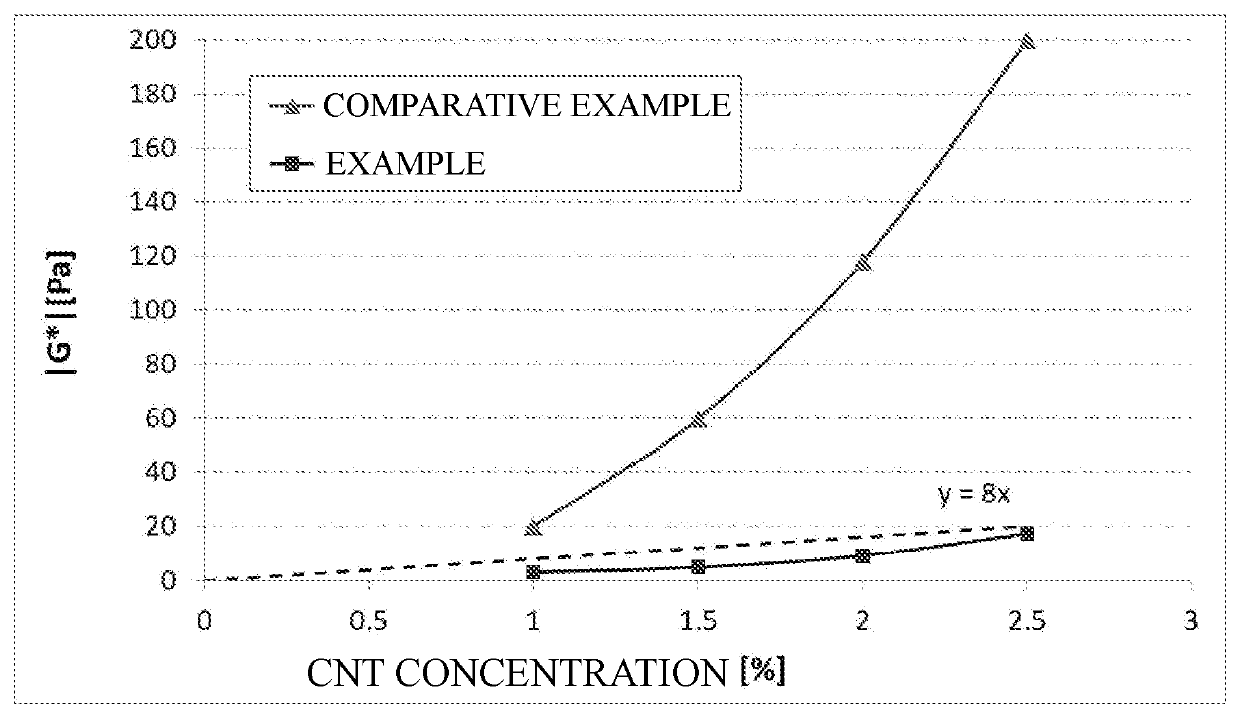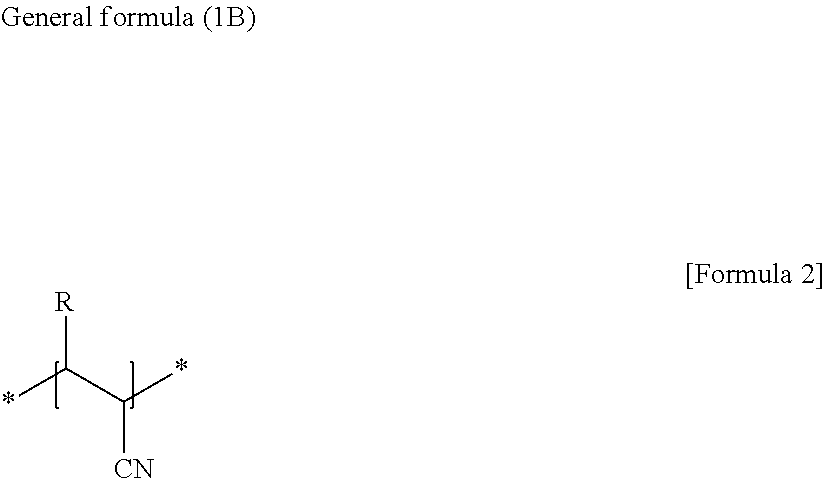Conductive material dispersion, binder resin-containing conductive material dispersion, slurry for electrode film, electrode film, and non-aqueous electrolyte secondary battery
a technology of conductive materials and dispersion, which is applied in the field of conductive material dispersion, can solve the problems of poor dispersion of nanocarbons, low dispersion efficiency, and near-limit improvement, and achieve good dispersion, good dispersion stability, and good dispersion
- Summary
- Abstract
- Description
- Claims
- Application Information
AI Technical Summary
Benefits of technology
Problems solved by technology
Method used
Image
Examples
synthesis example 1
lymer 1
[0272]To a stainless steel polymerization reactor, 35 parts acrylonitrile, 65 parts 1,3-butadiene, 3 parts potassium oleate soap, 0.3 parts azobisisobutyronitrile, 0.55 parts t-dodecyl mercaptan, and 200 parts ion-exchanged water were added. Under a nitrogen atmosphere, the polymerization was performed for 20 hours at 45° C. with stirring, and the polymerization was completed at a conversion rate of 90%. Unreacted monomers were removed by reduced pressure stripping to obtain acrylonitrile-conjugated diene rubber latex with a solid content concentration of approximately 30%.
[0273]Then, ion-exchanged water was added to the latex to adjust the total solid content concentration to 12%, and the latex was put into an autoclave with a stirrer with a volume of 1 L, and nitrogen gas was flowed for 10 minutes to remove the dissolved oxygen in the contents. The catalyst solution was prepared by dissolving 75 mg of palladium acetate as a hydrogenation catalyst in 180 mL of ion-exchanged ...
synthesis examples 2 to 8
2 to 8
[0276]The copolymers 2 to 8 were prepared in the same manner as that in Synthetic Example 1, except that the monomer composition used was changed according to Table 1, and the content of t-dodecyl mercaptan, which is a molecular weight modifier, was changed appropriately to achieve the target Mooney viscosity of the copolymers. The Mooney viscosities of the obtained copolymers 2 to 8 are shown in Table 1.
[0277]In addition, the abbreviations listed in the columns for monomers in Table 1 refer to the following.
[0278]BD: 1,3-butadiene
[0279]MBD: 2-methyl-1,3-butadiene
[0280]AN: Acrylonitrile
[0281]MAN: Methacrylonitrile
[0282]AAm: Acrylamide
[0283]BA: Butylacrylate
TABLE 1Mooney viscosityMonomer(ML1+4, CopolymerBDMBDANMANAAmBA100° C.)Copolymer 1653549Copolymer 26035553Copolymer 3802060Copolymer 44525151555Copolymer 565251050Copolymer 66533258Copolymer 761352265Copolymer 85520151090
Preparation of Conductive Material Dispersion (Example 1-1)
[0284]According to the composition shown in Ta...
examples 1-2 to 1-22
and Comparative Examples 1-1 to 1-5 and 1-7 to 1-10
[0287]In accordance with the composition shown in Table 2, each dispersion (dispersions 2 to 22 and comparative dispersions 1 to 5 and 7 to 10) was obtained in the same manner as that in Example 1-1.
[0288]As shown in Table 3, the conductive material dispersions (dispersions 2 to 22) of the present invention all had low viscosity and good stability. The pH measurement results of the dispersions 2 to 22 and the comparative dispersions 1 to 5 and 7 to 10 are shown in Table 2.
PUM
| Property | Measurement | Unit |
|---|---|---|
| Percent by mass | aaaaa | aaaaa |
| Pressure | aaaaa | aaaaa |
| Angle | aaaaa | aaaaa |
Abstract
Description
Claims
Application Information
 Login to View More
Login to View More - R&D
- Intellectual Property
- Life Sciences
- Materials
- Tech Scout
- Unparalleled Data Quality
- Higher Quality Content
- 60% Fewer Hallucinations
Browse by: Latest US Patents, China's latest patents, Technical Efficacy Thesaurus, Application Domain, Technology Topic, Popular Technical Reports.
© 2025 PatSnap. All rights reserved.Legal|Privacy policy|Modern Slavery Act Transparency Statement|Sitemap|About US| Contact US: help@patsnap.com



